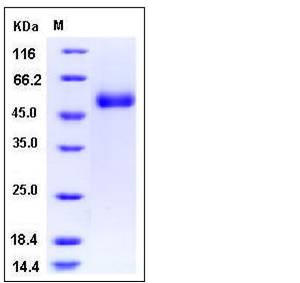Human ACPL2 Protein (His Tag)
ACPL2,FLJ23751,UNQ370/PRO706
- 100ug (NPP1864) Please inquiry
| Catalog Number | P11243-H08H |
|---|---|
| Organism Species | Human |
| Host | Human Cells |
| Synonyms | ACPL2,FLJ23751,UNQ370/PRO706 |
| Molecular Weight | The recombinant human ACPL2 consists of 468 amino acids after removal of the signal peptide and has a predicted molecular mass of 54 kDa. It migrates as an approximately 50 kDa band in SDS-PAGE under reducing conditions. |
| predicted N | Leu 24 |
| SDS-PAGE |  |
| Purity | > 95 % as determined by SDS-PAGE |
| Protein Construction | A DNA sequence encoding the human ACPL2 (NP_689495.1) (Met 1-Phe 480) precursor was fused with a polyhistidine tag at the C-terminus. |
| Bio-activity | |
| Research Area | |
| Formulation | Lyophilized from sterile PBS, pH 7.4 1. Normally 5 % - 8 % trehalose, mannitol and 0.01% Tween80 are added as protectants before lyophilization. Specific concentrations are included in the hardcopy of COA. |
| Background | acid phosphatase-like protein 2, also known as ACPL2, is a secreted protein which belongs to the histidine acid phosphatase family. A large-scale effort, termed the Secreted Protein Discovery Initiative (SPDI), was undertaken to identify novel secreted and transmembrane proteins. In the first of several approaches, a biological signal sequence trap in yeast cells was utilized to identify cDNA clones encoding putative secreted proteins. A second strategy utilized various algorithms that recognize features such as the hydrophobic properties of signal sequences to identify putative proteins encoded by expressed sequence tags (ESTs) from human cDNA libraries. A third approach surveyed ESTs for protein sequence similarity to a set of known receptors and their ligands with the BLAST algorithm. Finally, both signal-sequence prediction algorithms and BLAST were used to identify single exons of potential genes from within human genomic sequence. |
| Reference |
